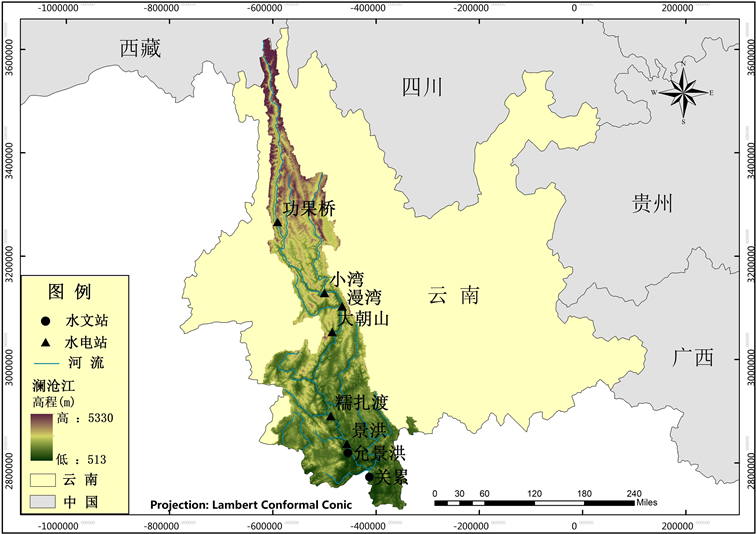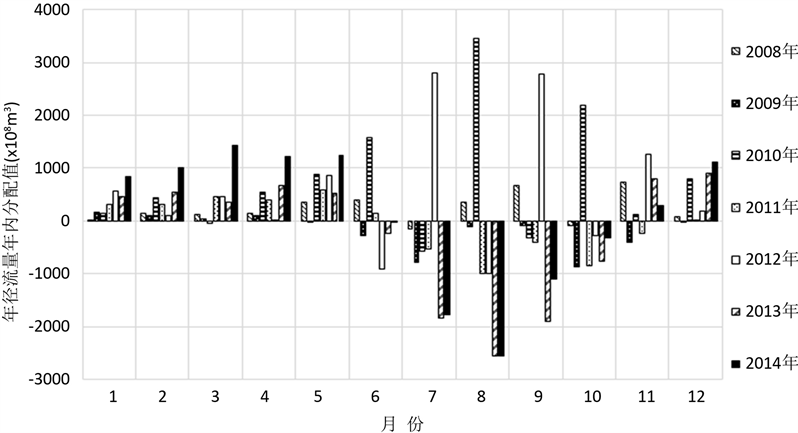Journal of Water Resources Research
Vol.
08
No.
03
(
2019
), Article ID:
30602
,
6
pages
10.12677/JWRR.2019.83029
Analysis on Transboundary Runoff Changes at Downstream of Jinghong Hydropower Station, Lancang River
Liuan Li1, Yating Dai2, Kaidao Fu2*
1Xishuangbanna Sub-Bureau of Yunnan Hydrology and Water Resource Bureau, Jinghong Yunnan
2Institute of International River and Eco-Security, Yunnan University, Kunming Yunnan

Received: May 8th, 2019; accepted: May 23rd, 2019; published: May 31st, 2019

ABSTRACT
The Lancang-Mekong River is the longest river in Southeast Asia flowing through five countries. With the operation of Jinghong Hydropower Station, the last hydroelectric station before the departure of the main stream of the Lancang River, its impact on the changes of the transboundary discharge of the Lancang River has attracted much attention from the downstream countries and the international community. Based on the runoff data of Yunjinghong and Guanlei hydrological stations in the lower reaches of Jinghong Hydropower Station, this paper studies the influence of Jinghong Hydropower Station on the runoff of the lower reaches before and after the construction of Jinghong Hydropower Station. The results show that: 1) the amount of water discharged from the upper reaches of the reservoir after the construction of the reservoir has a significant decreasing trend; 2) in dry season, the amount of water discharged after the construction of the reservoir increases compared with the amount of water coming from the upper reaches before the construction of the reservoir, while in flood season it decreases; 3) the proportion of water discharged from the lower season to the annual amount of water discharged increases, and the amount of water lost increases with the increase of the amount of water discharged in dry season. The research results can provide a basic reference for hydropower development and watershed management in Lancang River Basin.
Keywords:Runoff, Change Analysis, Jinghong Hydropower Station, Lower Reach of Lancang River
澜沧江景洪水电站下游出境水量变化分析
李刘安1,戴雅婷2,傅开道2*
1云南云省水文水资源局西双版纳分局,云南 景洪
2云南大学国际河流与生态安全研究院,云南 昆明

收稿日期:2019年5月8日;录用日期:2019年5月23日;发布日期:2019年5月31日

摘 要
澜沧江–湄公河是流经五国的东南亚第一长河,随着澜沧江干流出境前最后一个水电站景洪站的投入运行,其对澜沧江出境水量变化的影响倍受下游国家及国际社会的关注。本文运用景洪电站下游的允景洪、关累水文站径流资料,开展景洪站建立前后对其下游河段径流量的影响研究。结果显示,1) 建库后的下泄水量较建库前上游来水量具有明显减少趋势;2) 枯季时,建库后下泄水量较建库前上游来水量增大,而汛期则体现为减少;3) 枯季的下泄水量比重占全年下泄水量的比重增大,且损失水量随枯季下泄水量的增大而增大。该研究结果可为澜沧江流域水电开发及其流域管理提供基础依据。
关键词 :径流量,变化分析,景洪水电站,澜沧江下游

Copyright © 2019 by author(s) and Wuhan University.
This work is licensed under the Creative Commons Attribution International License (CC BY).
http://creativecommons.org/licenses/by/4.0/


1. 引言
澜沧江–湄公河乃我国与东南亚五国共饮一江水,我国境内澜沧江段自然资源开发等对我国西南地区地缘政治、地缘经济有着重要影响作用。澜沧江中下游开发条件理想,水能资源丰富,在云南河段内实现了梯级水电开发,汇集了全流域70%的水能资源。水利水电工程作为调控水资源的重要手段,解决区域水资源供需矛盾的同时,其建设也带来了径流改变、泥沙淤积、农田淹没、局域生态系统破坏等环境问题 [1] [2]。梯级水电开发通过对河流入库流量的调节,改变了河道径流原本分配过程,致使河流径流量减少,甚至断流,且该影响自上游到下游逐渐增大 [3] [4] [5]。钟华平等人研究发现澜沧江梯级水电站对径流影响具有累积效应,对下湄公河径流量具有显著的调节作用,尤其在梯级大坝蓄水前期,影响作用更加显著 [6]。顾颖等人对澜沧江梯级电站建设对下游水文情势展开研究,发现随着建成电站的增多,对下游的扰动影响也随之增大,且在下游出境处径流过程受扰动程度最大 [7]。随着澜沧江干流出境前最后一个水电站景洪站的投入运行,其对澜沧江出境水量变化的影响倍受下游国家及国际社会的关注。
本文运用景洪电站下游的允景洪、关累水文站径流资料,对建库前后水库下泄水量进行对比分析,可为该国际河流流域水资源管理提供一定的理论依据。
2. 水文观测站与水电开发
本研究流域如图1所示,澜沧江属典型的山地河流,主要由降水、地下水、冰雪融水补给。下游河段处在相对宽阔的槽型谷段,河谷沿程有宽窄相间的变化,主要呈现为中低山宽峡谷的特征,地势趋平缓,河道呈束放状,出国境后河道比较开阔平缓。

Figure 1. Study of watershed schematic maps
图1. 研究流域示意图
2.1. 水文站
允景洪水文站断面位于澜沧江下游河段,地理位置为东经100˚47',北纬22˚02',积水面积141,779 km2。断面上游3.5 km为景洪电站,其间无支流汇入,断面下游104 km处为出境口。允景洪水文站断面来水主要是景洪电站下泄水量 [8] [9]。
关累水文站于2007年1月由云南华能澜沧江水电有限公司设立,位于东经101˚10',北纬21˚45',积水面积158,300 km2,距上游允景洪水文站断面约78 km,距澜沧江出境口约26 km,基本断面控制良好呈U字形。关累水文站与允景洪水文站之间有流沙河、补远江和南阿河三条较大支流汇入。
2.2. 水电开发
目前,澜沧江干流上已先后建成了功果桥、漫湾、大朝山、小湾、糯扎渡和景洪等水电站。电站分布在分析断面上游各个河段,所以对分析断面的来水量起着至关重要的调节作用。特别是2008年6月19日蓄水发电的景洪电站,直接决定了允景洪水文站控制断面的水量,景洪电站的下泄流量就是允景洪水文站的控制来水水量。目前允景洪水文站下游无水利工程对澜沧江水量起到影响作用。
3. 景洪电站下游水量变化特征
3.1. 水量年际变化
根据允景洪水文站在景洪水电站建库前和建库后的水量进行分析对比,找出水量的变化特征。选用1988年~2007年20年允景洪水文站断面实测多年平均径流量 [10] 与2008年~2014年允景洪站断面实测径流量进行对比分析。
Table 1. Annual runoff comparison of Yunjinghong Station before and after the construction of Jinghong Hydropower Station
表1. 允景洪站在景洪水电站建库前后的年径流量对比(×108 m3)
注:Q为建库前多年平均径流量:564.5亿m3。
根据表1可以看出经过景洪电站调节控制以后的下泄水量较建库前的上游来水量相对减少了。最小为2008年减少了21.8亿m3,最大为2013年减少了176亿m3,总体而言为减少趋势。本文得出的水电站建成后下泄水量减少,与黄薇等人对金沙江屏山水文站在水电站建立前后进行23年水文监测 [11] 和朱玲在澜沧江开展的水电开发对下游河川径流影响得到的结果表现一致 [12]。这是由于电站水库通过拦截上游水源进行水电开发,对河流产生拦蓄作用,且因水库蒸发渗漏等原因,导致下泄水量减少。
3.2. 水量的年内分配
水量的年内分配选用1988年~2007年20年允景洪水文站断面实测多年平均年径流量年内分配[10]与2008年~2014年允景洪站断面实测径流量年内分配进行对比分析。分析情况如表2、和图1。
Table 2. Comparison of runoff distribution of Yunjinghong Station before and after the construction of Jinghong Hydropower Station
表2. 允景洪站在景洪水电站建库前后的年内分配径流对比(×108 m3)
注:表内流量为建库后月径流量减去建库前该月多年平均径流量。
根据表2和图2可以看出经过电站控制后下泄流量在枯季(1~5月,11~12月)远大于建站前的平均流量,而在汛期(6月~10月)则相反,特别是2011年、2013年和2014年较为明显。这是水电站进行防汛抗旱调度的结果,在枯季水电站开闸放水,增加下游径流量弥补天然径流不足,而在汛期电站通过对洪水进行拦蓄,防止下游径流量突增造成洪灾,从而达到丰蓄枯补的调蓄目标。
3.3. 水量变化特征
景洪电站下游段,即允景洪站下游至关累段,期间有流沙河、补远江和南阿河汇入。所以通过2008年至2014年允景洪站、勐海站(流沙河)和曼安站(补远江)三个站为上游站与关累站(澜沧江最后一个出口站)为下游站的年水量进行对比分析,来了解澜沧江下游段的水量变化特征。

Figure 2. Contrast diagram of runoff distribution of Yunjinghong Station before and after the construction of Jinghong Hydropower Station
图2. 允景洪站在景洪水电站建库前后的年内分配径流对照图
Table 3. Comparison of annual runoff of Guanlei station and Yunjinghong, Menghai and Man’an Station annual runoff from 2008 to 2014
表3. 2008年至2014年关累站年径流量与允景洪、勐海和曼安站年径流量对照表(×108 m3)
注:允景洪站和关累站区间主要有勐海(流沙河)和曼安(补远江)汇入。
从表3上下游站的水量平衡来看,除2010年和2014年外,各年水量上下游水量基本保持平衡。2010年和2014年的径流量出现区间水量损失情况。特别是2014年为例,区间水量损失大于32.3亿m3 (区间内还有南阿河支流未计水量),这是由于2014年径流量年内分配严重不均导致,具体情况如表2和图1所示,电站枯季下泄的径流量占年径流量的63%,而汛期仅占37%。所以可以看出,受电站调控影响下,在枯季下泄水量增大的情形下会产生大量的区间水量损失情况。
4. 结论
对景洪电站建库前20年的允景洪站上游来水量与建库后的水库下泄水量进行对比分析和对建库后电站下游段上下水文站之间的水量变化进行分析可以得到以下结论:
1) 建库后的下泄水量较建库前上游来水量出现明显减少趋势。
2) 枯季时,建库后下泄水量较建库前上游来水量增大,而汛期则体现为减少,说明景洪水电站对河流径流具有丰蓄枯补的调节作用。
3) 枯季的下泄水量比重占全年下泄水量的比重增大,特别是在枯季大量下泄水量会在下游河段内产生较大的水量损失,且损失水量随枯季下泄水量的增大而增大。
基金项目
国家自然科学基金项目(41571032, 41561144012)。
文章引用
李刘安,戴雅婷,傅开道. 澜沧江景洪水电站下游出境水量变化分析
Analysis on Transboundary Runoff Changes at Downstream of Jinghong Hydropower Station, Lancang River[J]. 水资源研究, 2019, 08(03): 242-247. https://doi.org/10.12677/JWRR.2019.83029
参考文献
- 1. WANG, G. H., FANG, Q. H., ZHANG, L. P., et al. Valuing the effects of hydropower development on watershed ecosystem services. Coastal and Shelf Science, 2010, 86: 363-368. https://doi.org/10.1016/j.ecss.2009.03.022
- 2. 刘昌明, 刘晓燕. 河流健康理论初探[J]. 地理学报, 2008, 63(7): 683-692. LIU Changming, LIU Xiaoyan. Healthy river: Essence and indicators. Acta Geographica Sinica, 2008, 63(7): 683-692. (in Chinese)
- 3. 陈进, 黄薇, 张卉. 长江上游水电开发对流域生态环境影响初探[J]. 水利发展研究, 2006, 6(8): 10-13. CHEN Jin, HUANG Wei and ZHANG Hui. Preliminary study on the impact of hydropower development in upper reaches of the Yangtze River on the eco-environment of the basin. Water Resources Development Research, 2006, 6(8): 10-13. (in Chinese)
- 4. 刘兰芬, 陈凯麒, 张士杰, 等. 河流水电梯级开水温累积影响研究[J]. 中国水利水电科学院学报, 2007, 5(3): 173-180. LIU Lanfen, CHEN Kaiqi, ZHANG Shijie, et al. Study on cumulative effects of water temperature by cascade hydropower stations built on rivers. Journal of China Institute of Water Resources and Hydropower Research, 2007, 5(3): 173-180. (in Chinese)
- 5. 李小荣. 大通河跨流域引水和梯级水电站建设对径流的影响分析[J]. 地下水, 2017, 39(4):134-136. LI Xiaorong. Analysis of the impact of iner-basin water diversion and cascade hydropower stations construction of Datong River on runoff. Ground Water, 2017, 39(4):134-136. (in Chinese)
- 6. 钟华平, 刘恒, 耿雷华. 澜沧江流域梯级开发的生态环境累积效应[J]. 水利学报, 2007(增刊): 577-581. ZHONG Ronghua, LIU Heng and GENG Leihua. Cumulative effects of Lancang River basin cascade hydropower development on ecology and environment. Journal of Hydraulic Engineering, 2007(Supplement): 577-581. (in Chinese)
- 7. 顾颖, 雷四华, 刘静楠. 澜沧江梯级电站建设对有下游水文情势的影响[J]. 水利水电技术, 2008, 39(4): 20-23. GU Ying, LEI Sihua and LIU Jingnan. Effects of cascade hydropower development on hydrological regime of Lower Lancang River. Water Resources and Hydropower Engineering, 2008, 39(4): 20-23. (in Chinese)
- 8. 王云花. 西双版纳地区水文特性分析[J]. 水文, 2003, 23(4): 55-59. WANG Yunhua. Analysis of hydrological characteristics in Xishuangbanna area. Hydrology, 2003, 23(4): 55-59. (in Chi-nese)
- 9. 周安辉. 澜沧江近20年泥沙变化特性分析[J]. 人民长江, 2012(43): 114-115. ZHOU Anhui. Analysis of sediment characteristics of the Lancang River in the past 20 years. Yangtze River, 2012(43): 114-115. (in Chinese)
- 10. 王亿春, 胡云萍. 浅析澜沧江上游水利工程对允景洪水文站水文要素的影响[C]//云南省水利学会四次理事会暨2014年度学术交流会, 2014: 244-248. WANG Yichun, HU Yunping. Analysis of the influence of the water conservancy project of the upper Lancang River on the hydrological elements of Yunjinghong station. Yunnan Hydraulic Engineering Society Association Fourth Council and 2014 Academic Exchange, 2014: 244-248. (in Chinese)
- 11. 黄薇, 陈进, 王波. 梯级开发对河流径流过程和水温过程均化作用的研究[J]. 长江流域资源与环境, 2010, 19(3): 335-339. HUANG Wei, CHEN Jin and WANG Bo. Study on averaging effect of cascade hydropower development on flow and water temperature process. Resources and Environment in the Yangtze Basin, 2010, 19(3): 335-339. (in Chinese)
- 12. 朱玲. 水电开发对下游河川径流及输沙特性的影响研究[J]. 人民长江, 2012, 43(6): 73-76. ZHU Ling. Effect of hydropower development on runoff and sediment transport characteristics of downstream rivers. Yangtze River, 2012, 43(6): 73-76. (in Chinese)
